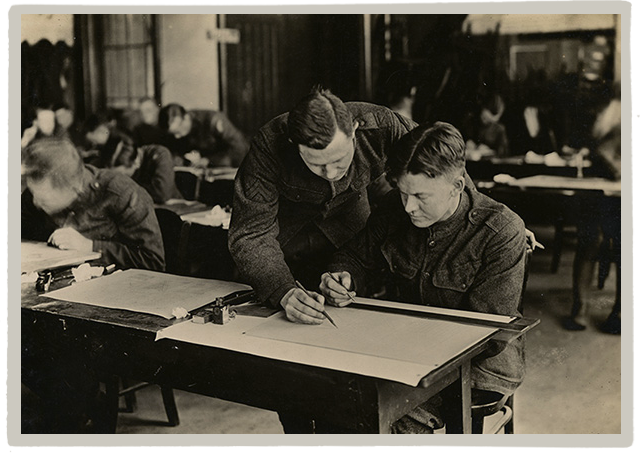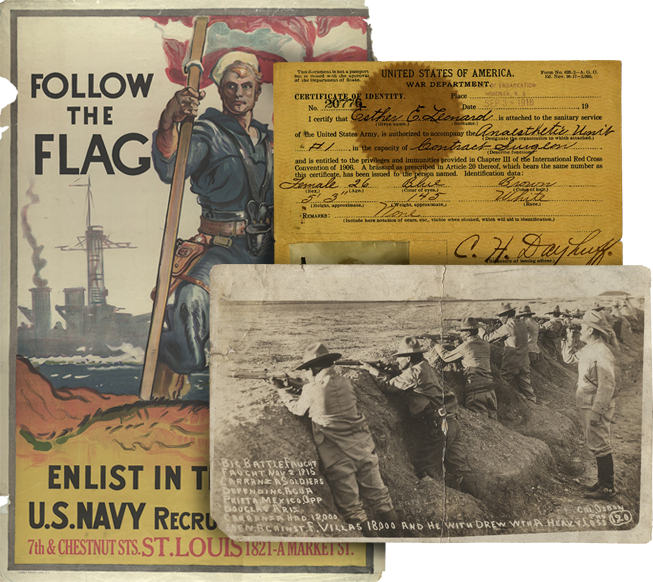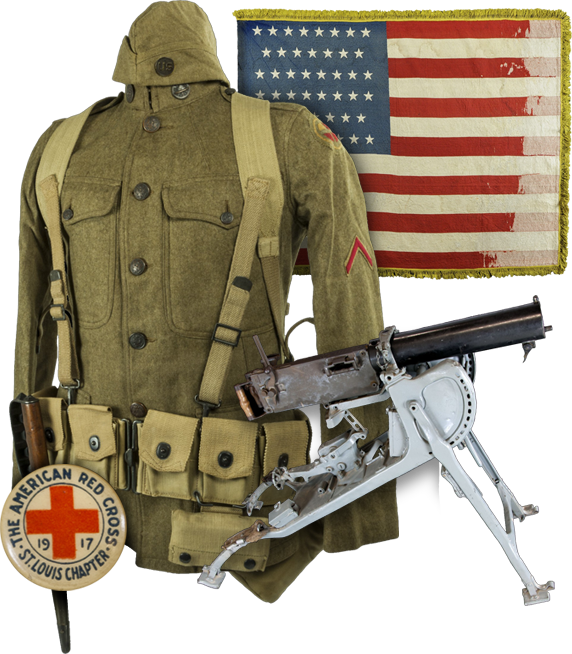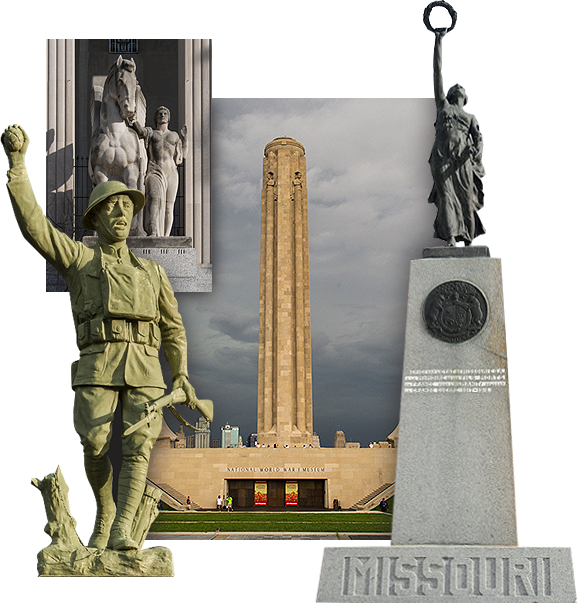Olive E. Wilcox Scrapbook - May 14, 1917-June 10, 1919

Transcript
Snapshots
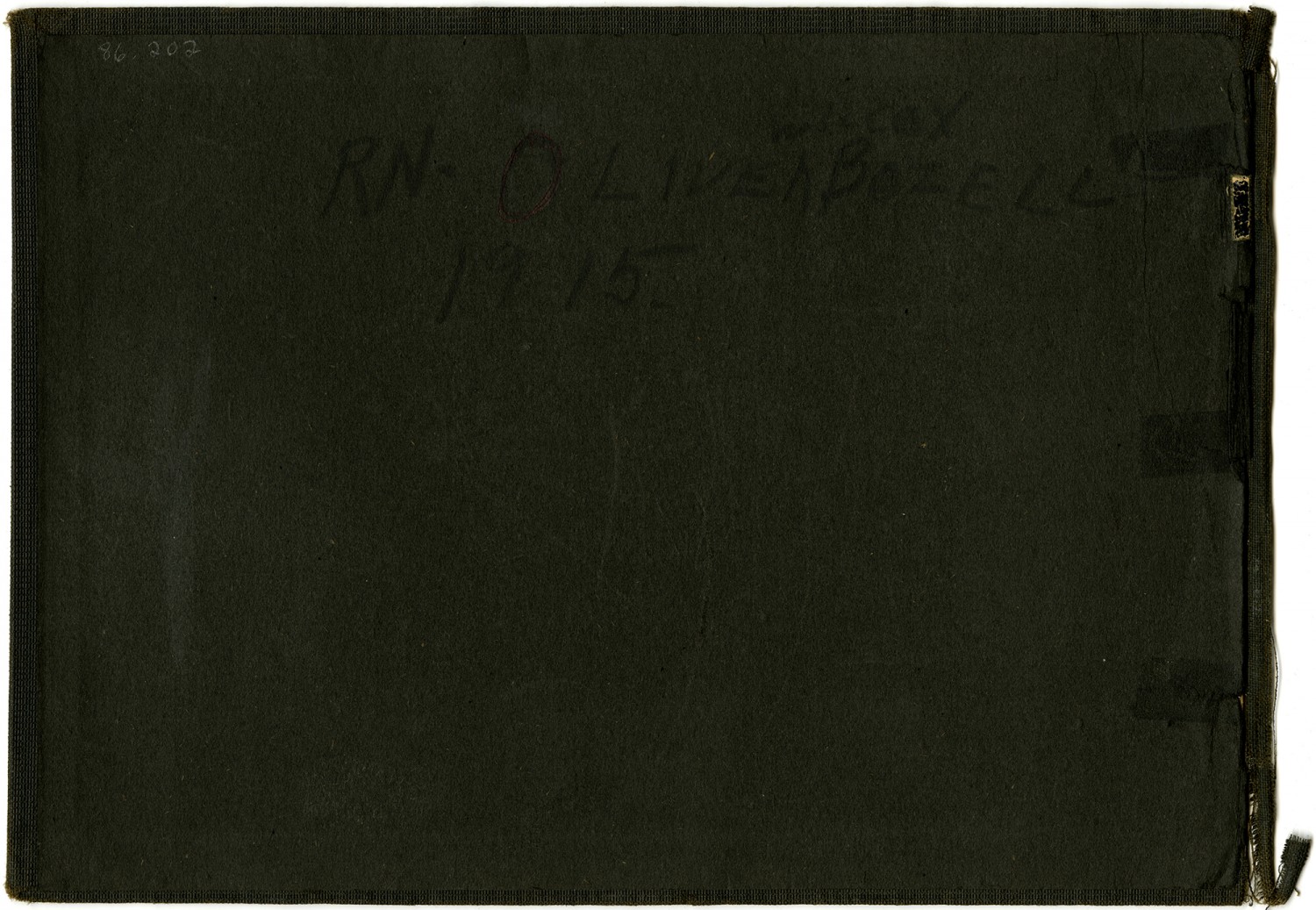
Transcript
RN OLIVE WILCOX BOZELL 1915

Transcript
[photograph] The grandstands - parade ground - partial view of the hospital camp, located entirely within the Race Course. Champ De Course.

Transcript
[photograph] Assembly ground for the troops, preparatory to going "up the line". Located across the Roman road from No. 12 general. During the March offensive 1918, 40,000 men went from this place every week.

Transcript
Nurses' Quarters. [photograph, top left] The Sisters Mess. [photograph, bottom left] Entrance from sisters quarters to the camp. [photograph, top right] Ordinary living huts - there were four of this size - each being divided into cubicles - [photograph, bottom right]

Transcript
[photograph, left] A forest hut - there were 15 of this size - four person to each hut. [photograph, right] Night nurses' tent - sleeping quarters - [photograph, center] Trenches provided for the nurses in case of air raids.

Transcript
[photograph, top left] Marquee tent - open - each tent contained 14 beds and 14 bedside lockers. [photograph, bottom left] [photograph, top right] Marquee tent - closed. [photograph, bottom right] Bell tent.

Transcript
[photograph] Observation balloon, a "Blimp" showing above [General Hospital No. 12].

Transcript
[photograph, left] One of the operating nurses. [One of the operating] orderlies. [photograph, right] Bill- Tom- both were in the operating theatre during the length of time while at No. 12. [photograph, center] One corner of operating theatre - there was sufficient room for five surgeons (under war conditions).

Transcript
[photograph, left] The British Y. M. C. A. building on the Race Course - was used jointly by Australian Gen. No I. British No. 10. American No. 12. [photograph, right] Was built exclusively for the use of our unit while at No. 12. by the [American Red Cross] Was finished about six months before the war ended.

Transcript
[photograph] The Bath House. The seats were used in case of a large convoy.

Transcript
[photograph, left] The Company cook-house. Frank Carr Harry Brown Hershel Storment Gashouse gang Williams. [photograph, right] The disinfector.

Transcript
[photograph, left] Dangerfield "Tommy" one of the pets of the N.Q.s. He was the son of "Whizzbang", a beautiful tiger Angora, who came to the camp while the British sisters were in charge. [photograph, center] Justine or Esther - she with her family fled from Liege, Belgium, in 1914. Came to Rouen the same year, where she with her moth and older sister became maids in the Sisters' Quarters. They left only when the entire camp had been evacuated. Justine [photograph, right] Peter Blueboy "Peter", another pet in the N.Q.s. When the Unit left for American, Peter attached himself to the personnel but was lost enroute to Brest. A "Blueboy".

Transcript
Places of interest near Rouen. [photograph] The ferry at [Petit Quevilly] on the Seine.

Transcript
[photograph, left] On "sentry-go". Guarding the guard-house, otherwise known as the "clink". [photograph, center] View in Men's Quarters [photograph, right] One of our English padres - Padre Edwards, Non-Conformist.

Transcript
[photograph]East Indian Cavalry Base Depot. Showing the Hindoo troops at practice, on mounting. This was one of the largest bases for the Indian troops. We often saw the famous Lancers at practice.

Transcript
[photograph, top left] Donkey and cart (peasant

Transcript
Scenes in Brittany. On the northern sea-coast. [photograph] Gateway into Mont St. Michel.

Transcript
[photograph] The beach and wall - St. Malo.

Transcript
[photograph] The drive along the beach at Dinard.

Transcript
[photograph, left] Chateau on a rocky point at Dinard. [photograph, top right] Rear view of the hotel at Parame. [photograph, bottom right] Grand Hotel De Parame.

Transcript
[photograph, top left] [photograph, top center] [photograph, top right] Scenes on the beach at Dinard. [photograph, bottom left] Miss Idle. [photograph, bottom right] Miss Schmitt.

Transcript
[photograph, top left] At Dinard - A Scotch officer of the "Black Watch". A British officer of the [Royal Fleet Auxiliary] [photograph, top center] Me & Dolly Schmitt [photograph] Me On the promenade at Dinard - a favorite pastime for the children [photograph, bottom] Jock Ruby Idle Capt

Transcript
Scenes in the Riviera. [photograph] On the border between France and Italy - view of a terraced mountain - the famous vineyards of the [Maritime Alps] are grown on these terraces.

Transcript
[photograph] Menton and the [Mediterranean Sea] from the tower of grimaldi Palace.

Transcript
[photograph] View of Cannes from the bay enroute to the Lerin Islands.

Transcript
[photograph] Promenade des Anglais at Nice. Considered one of the most beautiful promenades in the world. Nice, being considered the most popular of the Riviera resorts.

Transcript
[photograph, left] A group of Algerian horsemen passing the Hotel Ruhl et Anglais on the promenade at Nice. [photograph, right] Woman with a load of baskets along the Promenade des Anglais, Nice.

Transcript
[photograph, left] In the Municipal garden at Nice. [photograph, center] On the promenade near a restaurant hanging over the sea. Miss Carfrae. [photograph, right] An American infantry officer with French children on the Promenade.

Transcript
[photograph, left] The sun-dial at Monte Carlo. The Casino in the background. [photograph, right] MONTE CARLO Casino Closed During La Guerre In the Casino gardens - statuary terraces, seats and etc. are of pure white marble.

Transcript
[photograph, left] Near the Italian border. This bridge is considered famous; was cut out of the mountain. The house in the distance is on Italian soil. [photograph, top right] Monte Carlo (panoramic view) taken from La Turbie (from the mountain top.) Notice the "Dog's Head". "Le Tete du Chien". [photograph, bottom right] Me Menton and a range of the Alps from the bridge.

Transcript
[photograph, left] Casino garden, Monte Carlo. January 1919. [photograph, center] Monte Carlo - pavilion. [photograph, right] Promenade des Anglais, Nice. January, 1919.

Transcript
Scenes of the Argonne Forest. [photograph] French barracks at La Grange-aux-Bois en Argonne - these barracks were used by our Mobile Unit during the part of the Argonne battle. Note the "duck-boards".
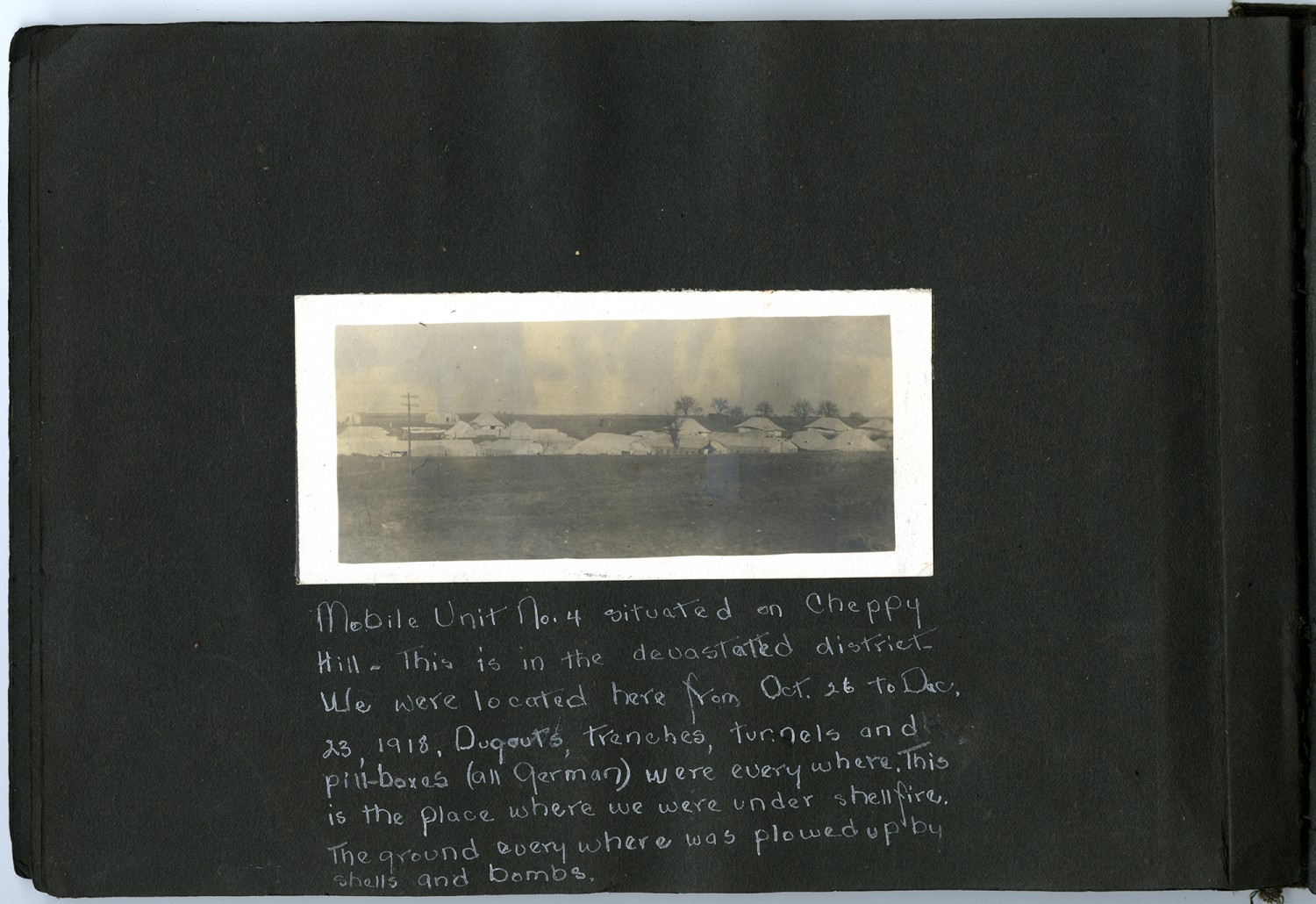
Transcript
[photograph] Mobile Unit No. 4 situated on Cheppy Hill. This is in the devastated district. We were located here from [October 26, 1918] to [December 23, 1918]. Dugouts, trenches, tunnels and pill-boxes (all german) were everywhere. This is the place where we were under shellfire. The ground everywhere was plowed up by shells and bombs.

Transcript
[photograph, top left] Cheppy Showing a shell-hole. I am standing at the bottom of the crater and Miss Scott about halfway up. [photograph, center left] Some of the Mobile Nurses with Lt.-Col. Clopton. [photograph, bottom left] Some of the Mobile Nurses with Lt. Johnny Odgen Note, The camions in the background. [photograph, center] Lt.-Col. Clopton, the C.O. of Mobile Unit No. 4. [photograph, top right] Close view of the hospital tents. (Cheppy). [photograph, center right] With the Graves Registration officer in locating some graves. [photograph] These were taken after the armistice was signed.

Transcript
[photograph] Hodgson Scott Morton Col. Otis Venable Staff Nurses and Team Nurses of Mobile Unit No. 4. with Lt.-Col. Clopton.

Transcript
[photograph] Nurses and officers of Mobile Unit No. 4.

Transcript
[photograph] Interior of one of the hospital tents of Mobile No. 4.

Transcript
[photograph, top] Me - Lt. Odgen - Aspel Baby tanks - at the tank depot in Varennes. [photograph, bottom left] [photograph, bottom right] Views of german dugouts at Prince Rupert's H.Q.s. in the Argonne Forest. The "Marble Palace" being the last word in dugouts deluxe. This underground city is to be preserved as a war relic.

Transcript
[photograph, left] At Newport News. [photograph, center] In training at Fort Sill, Oklahoma. [photograph, right] Guard duty.

Transcript
[photograph] Harry M. Wilcox, Co. M. 139th U.S. Infantry. Entered Service July, 1917. 35th Division. Sailed for France [April 1918]. Discharged - May 1919.

Transcript
[photograph] The British Sisters and U.A.D.' at No. 12 gen. Hosp. [British Expeditionary Force], Rouen, France.

Transcript
[photograph, top left] Pte. Roberts [Australian Imperial Force] Patient at No. 12 Gen. [photograph, bottom left] Miss Venable. [photograph, center] Miss Rachel Watkins, dietitian with [Base Hospital No. 21]. [photograph, top right] [photograph, bottom right] The Virginia girls with [Base Hospital No. 21].

Transcript
[photograph left] [photograph right] Miss Ann Westman. One of the [Kansas City] nurses with the St. Louis Unit. The field uniform shown, the original kind worn by our group. After being transferred to the Army from the Red Cross, the regular Army uniform was supplied.

Transcript
Mike Brown [photograph]

Transcript
Olive E. Wilcox. [Army Nurse Corps] U.S.A. Entered the Service - May 14, 1917. [Base Hospital No. 21]. or No. 12 Gen. (St. Louis, U.S.A.) [British Expeditionary Force] Known as the latter while with the British. Sailed for France - May 19, 1917. Transferred to the American Forces [August 20, 1918] - Our organization was known as Mobile Unit No. 4. Returned to No. 12 Gen. [December 23, 1918]. Sailed for the States early in [April 1919]. Discharged from the Service - June 10, 1919.

Transcript
[photograph] Original group of nurses of St. Louis Unit No. 21. Taken at Liverpool, England, May, 1917.

Transcript
[photograph, top left] Nurses of Base Hospital No. 21 (St. Louis Unit) on board the St. Paul. [photograph, bottom left] The ten [Kansas City] nurses with St. Louis Unit and Capt. Francisco on board ship. [photograph, right] Major Kopple QM. with Base Hospital No. 21.

Transcript
[photograph] The uniform worn on duty in camp. Miss Myrtle Nash.

Transcript
These photographs are the French official [photograph] At the celebration of the first anniversary of Base Hospital No. 21 in France. Celebrated by the staging of an ordinary circus. Visitors from all the surrounding camps attended. View of the principal grandstand.

Transcript
Wilcox [photograph] The Gateway at No. 12. British Base Hospital, Rouen, France. [British Expeditionary Force]

Transcript
Menard Croissant [photograph] The Lodge - just inside "the gate - occupied by the French keeper - view of a famous old Roman highway.

Transcript
[photograph, top left] [photograph, bottom left] Sand-bagged huts - for protection from bombs - the entirely helpless patients occupied these wards. Capacity of each - 36 to 40. [photograph, top right] German prisoners at work - armed guard not in sight. [photograph, bottom right] Nissen hut - made of corrugated iron - capacity - 24 patients.
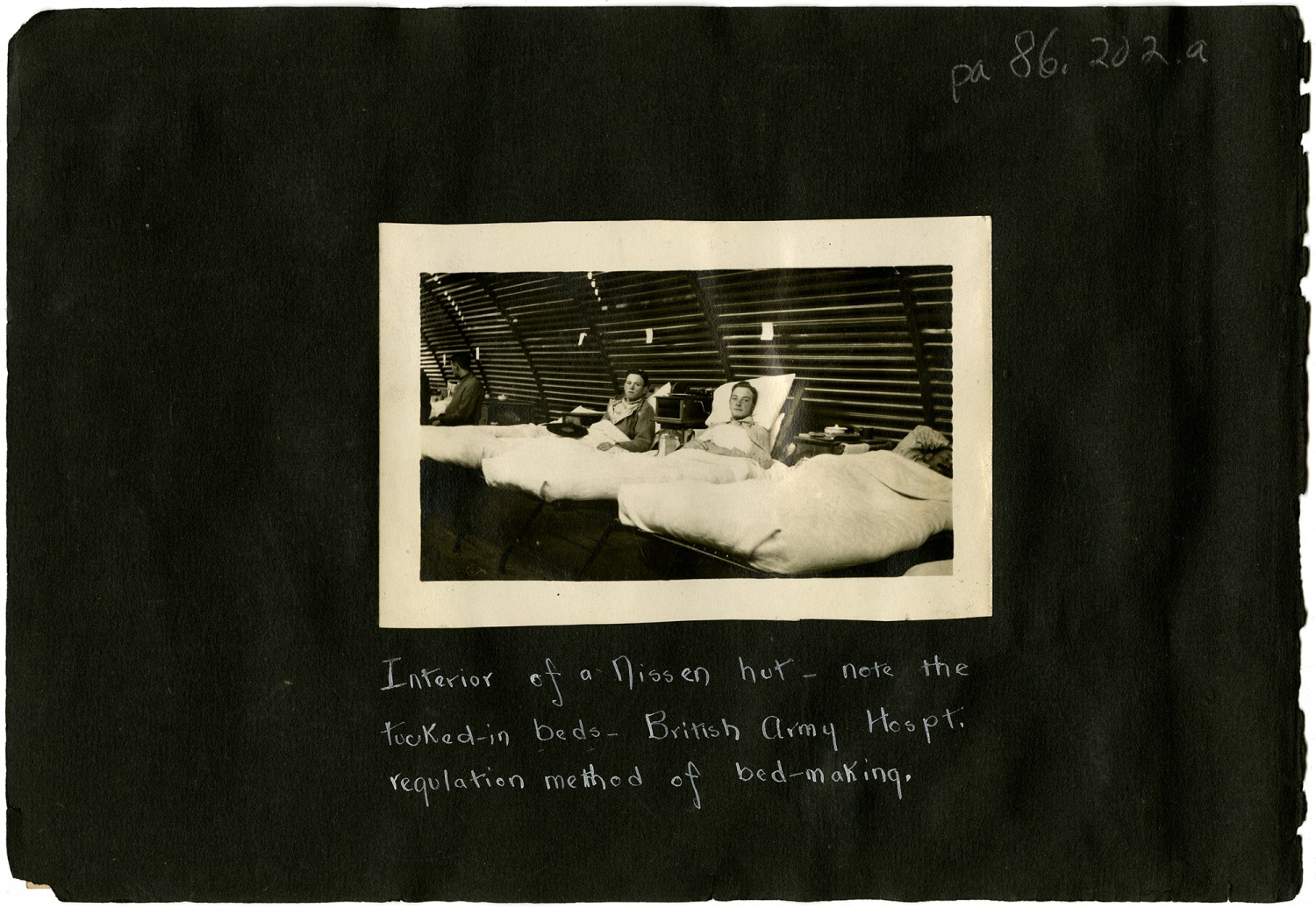
Transcript
[photograph] Interior of Nissen hut - note the tuck-in beds. [British Army Hospital]. regulation method of bed-making.

Transcript
[photograph, left] The ancient Church of the Rock at St. Adrienne on the Seine. In this church is to be found the pincushion and its legend. [photograph, right] View of one of the pine forests.

Transcript
[photograph, top] View of an infantry base depot. [photograph, bottom left] Across the road from the hospital camp. [photograph, bottom right] A British [Voluntary Aid Detachment] ambulance- driver.

Transcript
[photograph] The train from the Champs de Course to the city. Rouen - a distance of four miles - operated by women. Inside capacity of car, 20 persons.

Transcript
[photograph, left] Division line between No. 12 and No. 10. Flagstaff flying the Stars and Stripes, the Union Jack, with the Red Cross between. These flags were lowered each evening and night lights supplied. Note the flower bed. [photograph, top right] View of one corner of the race course [photograph, bottom right] Blencoe Another view of the flags.

Transcript
[photograph, top] The men at "Retreat". This maneuver took place at 5:00 p.m. daily. [photograph, bottom left] "The Point" - place where all incoming and outgoing convoys were handled. Between 60,000 and 70,000 patients passed thru here during 18 mos. [photograph, bottom right] View of some of our hospital tents.

Transcript
[photograph, left] View of a "line" - a "line" consisted of from seven to nine marquee tents or of a combination of several Nissen huts. Bell tent was used as an office. Note the stone edging of the "streets". This was done by "up" patients merely for diversion. [photograph, right] View of another "line" showing trenches that were used in case of an raid. Medical and slightly wounded patients occupied these tents, and when the "alert" was given, they were ordered to these trenches. Most of these tent coverings were camouflaged, but they do not show.

Transcript
[photograph] Maypole Dance - by the nurse - The dresses were made of hospital gauze. This picture gives a good view of the tent section of the camp.

Transcript
[photograph] Taken at Topeka at the Home-coming of the 139th U.S. Infantry, 35th Division. Harry arrived.

Transcript
[photograph, left] "Mike" the chief cook of Mobile No. 4. Was a former infantry man, twice wounded. Taken near a typical dugout. [photograph, right] Comatt Neely Mike Duffy Entire mess and kitchen personnel of Mobile No. 4. Get a good look at the mud and duck-boards.

Transcript
[photograph, left] [photograph, right] With trench coats, helmets and gas masks.

Transcript
[photograph, insert]

Transcript
[photograph, insert]

Transcript
[photograph, insert]

Transcript
[photograph, insert]

Transcript
[photograph, insert]

Transcript
[photograph, insert]

Transcript
[photograph, insert]

Transcript
[photograph, insert]

Transcript
[photograph, insert]

Transcript
[photograph, insert]
Details
| Title | Olive E. Wilcox Scrapbook - May 14, 1917-June 10, 1919 |
| Creator | Wilcox, Olive E. |
| Source | Wilcox, Olive E. Olive E. Wilcox Scrapbook. 14 May 1917-10 June 1919. Olive E. Wilcox Collection, 1917-1919. 1986.202. The National World War I Museum, Kansas City, Missouri. |
| Description | This scrapbook covers the military service of Olive E. Wilcox. Wilcox served with the Army Nurse Corps at Base Hospital 21 in France. The scrapbook outlines Wilcox's travels throughout France and gives a photographic tour of the base hospital buildings. |
| Subject LCSH | United States. Army Nurse Corps.; United States. Army. Base Hospital 21; United States. Army. Division, 35th; Hospital buildings; Intrenchments.; Tents; World War, 1914-1918--Aerial operations; Airships; World War, 1914-1918--War work--Y.M.C.A.; World War |
| Subject Local | WWI; World War I; East Indian Cavalry; Algerian Horsemen; 139th Infantry |
| Site Accession Number | 1986.202 |
| Contributing Institution | National World War I Museum and Memorial |
| Copy Request | Transmission or reproduction of items on these pages beyond that allowed by fair use requires the written permission of the National World War I Museum and Memorial: (816) 888-8100. |
| Rights | The text and images contained in this collection are intended for research and educational use only. Duplication of any of these images for commercial use without express written consent is expressly prohibited. |
| Date Original | May 14, 1917-June 10, 1919 |
| Language | English |
